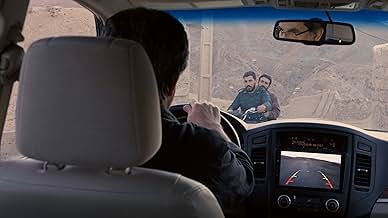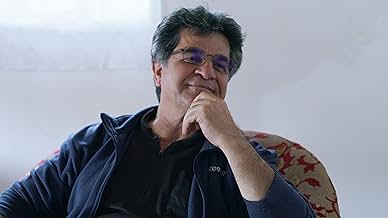ÉVALUATION IMDb
7,2/10
4,7 k
MA NOTE
Deux histoires d'amour parallèles alors que les partenaires sont contrecarrés par des obstacles cachés inévitables, la force de la superstition et les mécanismes du pouvoir.Deux histoires d'amour parallèles alors que les partenaires sont contrecarrés par des obstacles cachés inévitables, la force de la superstition et les mécanismes du pouvoir.Deux histoires d'amour parallèles alors que les partenaires sont contrecarrés par des obstacles cachés inévitables, la force de la superstition et les mécanismes du pouvoir.
- Prix
- 4 victoires et 8 nominations au total
Bakhtiyar Panjeei
- Bakhtiar
- (as Bakhtiar Panjei)
Narges Delaram
- Ghanbar's mother (Madar_e Ghanbar)
- (as Narjes Delaram)
Reza Heidari
- Reza
- (as Reza Heydari)
Aliye Tuzun
- Police
- (as Aliye Tüzün)
Avis en vedette
The way Jafar Panahi successfully transcends and exceeds all the limits in his filmmaking always leaves me mind-boggled and is fascinatingly masterful. This viewing experience left me with a question "To what extent are you willing to go to tell your story?"
No Bears takes us through a powerful journey of sophisticated simplicity that expands boundaries and defies censorship restrictions both mentally and physically and in a blend of fiction and realism with a story of adaptive determination in creating, fear of crucial decisions, and passion for the story.
His ability to shape the narrative with all these elements is beyond impressive as Panahi sheds his lens on a parallel story between reality and fiction under the premise of hope, while metaphorically introducing a bigger political theme of the fear of modern authority versus the absurdity of the superstition that remains a common element in both narratives including the self-reflexively portrayal of himself as a character, which also introduces an intimate layer.
The storytelling crafts beautifully palpable emotions some of which are felt indirectly, where the sense of fear and threat are always visible and kept translating different feelings so well through an observative lens.
No Bears takes us through a powerful journey of sophisticated simplicity that expands boundaries and defies censorship restrictions both mentally and physically and in a blend of fiction and realism with a story of adaptive determination in creating, fear of crucial decisions, and passion for the story.
His ability to shape the narrative with all these elements is beyond impressive as Panahi sheds his lens on a parallel story between reality and fiction under the premise of hope, while metaphorically introducing a bigger political theme of the fear of modern authority versus the absurdity of the superstition that remains a common element in both narratives including the self-reflexively portrayal of himself as a character, which also introduces an intimate layer.
The storytelling crafts beautifully palpable emotions some of which are felt indirectly, where the sense of fear and threat are always visible and kept translating different feelings so well through an observative lens.
The movie "No Bears" has a sensitive and dramatic plot against the backdrop of political, religious, tradition, and cultural repression in the current Iranian world. There are two love stories told in parallel by the excellent director Jafar Panahi, who himself suffers military repression for his political movies that challenge the dictatorial Iranian government. Jafar Panahi manages to capture and transmit all the tension that Iranians suffer under the eyes of the so-called Cultural Police. We sense the pressure in the air and nobody wants to compromise or get involved or close to citizens considered traitors to the country and to the traditional customs.
Like many other incredible Iranian movies, "No Bears" is second to none in terms of quality. Simple in showing the daily life of a village and the background of filming a movie, but also bold in showing us what it's like to live in a repressive regime and not bend.
Like many other incredible Iranian movies, "No Bears" is second to none in terms of quality. Simple in showing the daily life of a village and the background of filming a movie, but also bold in showing us what it's like to live in a repressive regime and not bend.
Telling the truth is difficult for Iranian filmmakers. You have Government control on one hand (the real tale of Panahi remotely directing a film being shot in Turkey while stationed on the borders of Iran as he is not allowed to leave the country) and you have quaint traditions on the other (in the Iranian villages on the border) that often lead to tragedy. However good your intent, the road is bumpy and leads you to a sad, nihilistic end. Intelligent filmmaking that captures the difficulty of renowned filmmakers to capture the Kafkesque ground reality in Iran and the frustrations of Iranian nationals today. Deserved the Special Jury Prize at Venice.
The film "No Bears" starts off simple but becomes more complex as it progresses. Even if you're not familiar with the work of Kiarostami and Makhmalbaf, you can still enjoy it. The director, Panahi, mixes documentary-style and autobiographical elements to create a powerful emotional impact. Panahi, who is at the center of the film, is forced to confront the consequences of his work, both for himself and his collaborators. The final image of the film is sobering and resonates with the unspoken anguish of an artist exiled in his own country, who has had enough. It is clear that the director has little left to lose, and this makes "No Bears" one of the best movies of the previous year.
In 'No Bears', Jafar Panahi plays a clever game with his viewers. We see a film about the making of a film. But is this film within the film really a film, or is it reality being filmed? It sounds terribly complicated, but it isn't.
Basically, 'No Bears' consists of two parallel stories, with Jafar Panahi, who plays himself, as connecting element. Panahi, who is not allowed to leave Iran, has rented a room in a tiny village close to the Turkish border. From there, he supervises the making of a film on the other side of the border. He tries to make internet connection with his crew, but the technology fails. No worries: his assistent can cross the border freely with a hard drive containing the rushes.
By coincidence, Panahi gets involved in a bitter conflict between two family clans in the village. This is the first story. It starts relatively calm with the request to erase a photo Panahi has made. The villagers are at first visibly embarassed to disturb their distinguished guest from Teheran. It is nice to see the contrast between the villagers, who live according to ancient traditions, and the sophisticated Panahi with his MacBook and modern cameras. The conflict gets more and more serious, and ends in a tragedy.
The controversial photo itself is never shown. Here, Panahi plays again with reality. The event he has photographed may or may not have happened. He never admits having taken the photo. What the villagers want, is the evidence of its existence, or non-existence. But how can you prove something doesn't exist?
The second story is the film Panahi is making, set in Turkey. It is about an Iranian couple trying to flee to Europe. But soon it appears that the movie doesn't follow a written script. The couple are not actors, but real life refugees, and the camera follows their attempts to get out of the country. Sometimes, the crew adresses Panahi directly through the camera. It seems the fourth wall is being broken, but at the same time it isn't because we are looking at the film within the film.
Both stories are about a couple in love, and both have unhappy endings. In one very unsettling scene, Panahi is accused by one of his 'actors' to adapt reality, in order to film a happy ending. This, of course, is exactly what film making is about. Panahi's decision to film not one, but two unhappy endings is probably inspired by the unhappy situation he himself and his country are in. Panahi has been harassed for years by the Iranian regime. He has recently been released from prison, after starting a hunger strike.
In spite of this, 'No Bears' is not a sombre movie. The events in the village are in a way very amusing and even funny. Panahi himself never loses his cool and confronts the villagers in his own way: with a camera.
Basically, 'No Bears' consists of two parallel stories, with Jafar Panahi, who plays himself, as connecting element. Panahi, who is not allowed to leave Iran, has rented a room in a tiny village close to the Turkish border. From there, he supervises the making of a film on the other side of the border. He tries to make internet connection with his crew, but the technology fails. No worries: his assistent can cross the border freely with a hard drive containing the rushes.
By coincidence, Panahi gets involved in a bitter conflict between two family clans in the village. This is the first story. It starts relatively calm with the request to erase a photo Panahi has made. The villagers are at first visibly embarassed to disturb their distinguished guest from Teheran. It is nice to see the contrast between the villagers, who live according to ancient traditions, and the sophisticated Panahi with his MacBook and modern cameras. The conflict gets more and more serious, and ends in a tragedy.
The controversial photo itself is never shown. Here, Panahi plays again with reality. The event he has photographed may or may not have happened. He never admits having taken the photo. What the villagers want, is the evidence of its existence, or non-existence. But how can you prove something doesn't exist?
The second story is the film Panahi is making, set in Turkey. It is about an Iranian couple trying to flee to Europe. But soon it appears that the movie doesn't follow a written script. The couple are not actors, but real life refugees, and the camera follows their attempts to get out of the country. Sometimes, the crew adresses Panahi directly through the camera. It seems the fourth wall is being broken, but at the same time it isn't because we are looking at the film within the film.
Both stories are about a couple in love, and both have unhappy endings. In one very unsettling scene, Panahi is accused by one of his 'actors' to adapt reality, in order to film a happy ending. This, of course, is exactly what film making is about. Panahi's decision to film not one, but two unhappy endings is probably inspired by the unhappy situation he himself and his country are in. Panahi has been harassed for years by the Iranian regime. He has recently been released from prison, after starting a hunger strike.
In spite of this, 'No Bears' is not a sombre movie. The events in the village are in a way very amusing and even funny. Panahi himself never loses his cool and confronts the villagers in his own way: with a camera.
Le saviez-vous
- AnecdotesActually, the entire scene shot in Istanbul Kadikoy, not in Turkish border town.
Meilleurs choix
Connectez-vous pour évaluer et surveiller les recommandations personnalisées
- How long is No Bears?Propulsé par Alexa
Détails
Box-office
- Brut – États-Unis et Canada
- 167 333 $ US
- Fin de semaine d'ouverture – États-Unis et Canada
- 6 173 $ US
- 25 déc. 2022
- Brut – à l'échelle mondiale
- 1 196 288 $ US
- Durée
- 1h 46m(106 min)
- Couleur
- Rapport de forme
- 1.85 : 1
Contribuer à cette page
Suggérer une modification ou ajouter du contenu manquant























